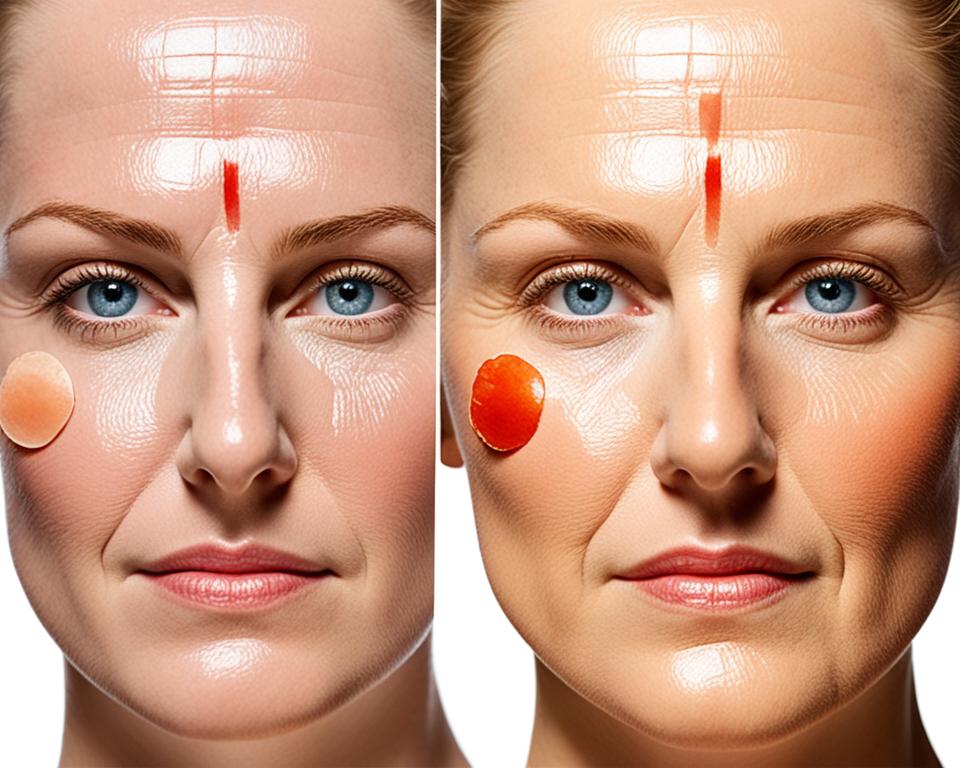Understanding Skin Issues: Causes, Symptoms, and Effective Solutions
Our skin is the biggest organ in our body. It’s very important for our health and looks. Knowing about common skin problems and what causes them is key to having healthy skin. We’ll look at different skin issues, their signs, and how to fix them. This guide aims to help you keep your skin healthy and glowing.
Key Takeaways
- Skin disorders vary greatly in symptoms and severity, ranging from temporary to permanent and painless to painful.
- Some skin issues have situational causes, while others may be genetic or indicate a more serious underlying condition.
- Consulting a dermatologist is recommended if you suspect you have a skin condition that requires medical attention.
- Proper skincare routines, sun protection, and lifestyle changes can help manage and prevent many common skin problems.
- Early detection and treatment are crucial for addressing skin conditions, especially for more serious conditions like skin cancer.
Common Skin Disorders and Their Symptoms
Our skin is the biggest organ in our body. It can get different skin disorders. Acne, cold sores, blisters, and hives are some common ones. Knowing what these look like can help you deal with them fast.
Acne
Acne is a common skin issue, especially for teens. It shows as red spots, blackheads, whiteheads, pimples, or big, painful cysts. These can be on your face, neck, shoulders, chest, and back.
Acne can leave scars or make your skin darker if not treated. This is more likely in darker skin tones.
Cold Sores
Cold sores, or fever blisters, are small, red, painful spots. They fill with fluid and usually show up near your mouth and lips. They spread easily and are caused by a virus.
Blisters
Blisters are clear, fluid-filled spots on your skin. They can happen from rubbing, burns, or certain skin problems. They can hurt a lot.
Hives
Hives make your skin itchy and swell up. They can happen from allergies to food, medicine, or things in your environment. They can change size and where they are and can go away quickly.
If you have any of these skin issues, see a doctor right away. They can help you feel better and stop more problems.

Skin Conditions Caused by Sun Exposure
Too much sun can cause skin problems. Actinic keratosis and rosacea are two main issues. Knowing about these is key to keeping your skin healthy.
Actinic Keratosis
Sun exposure can lead to actinic keratosis. It shows up as thick, scaly spots on the skin. These spots often appear on sun-exposed areas like the hands, arms, face, scalp, and neck.
If not treated, these spots could turn into skin cancer. It’s important to catch and treat them early.
Rosacea
Rosacea is a long-term skin condition with ups and downs. It can be set off by spicy foods, alcohol, sun exposure, stress, and a certain gut bacteria. Signs include red skin, visible blood vessels, and acne-like spots.
Using sun protection and making lifestyle changes can help manage rosacea. This keeps symptoms under control and stops flare-ups.
It’s key to shield your skin from UV rays and deal with sun-related skin issues quickly. If you’re worried about actinic keratosis, rosacea, or other skin conditions, talk to a skin doctor.

Bacterial and Viral Skin Infections
Skin infections can come from bacteria or viruses. Each type has its own signs and ways to treat it. Knowing the difference is key to handling and preventing them.
Carbuncles
Carbuncles are a kind of bacterial skin infection. They make a painful, red lump under the skin. You might also feel fever, body aches, and get very tired.
Getting the right treatment, like antibiotics, is important. This helps stop the infection from getting worse and turning into a big problem.
Cellulitis
Cellulitis is a serious bacterial skin infection. It makes the skin hurt, swell up, and spread fast. This is a big deal and needs quick action.
You’ll likely need antibiotics through a vein to fight it. This stops more problems from happening.
Measles
Measles is a very contagious viral skin infection. It shows with a red rash. Before the rash, you might feel fever, have a sore throat, and feel tired.
You might also have red eyes, lose your appetite, cough, and have a runny nose. Thanks to vaccines, measles is less common now.
“Recognizing the signs and symptoms of different skin infections is crucial for seeking timely and appropriate medical care.”
Getting the right diagnosis and treatment is key for handling bacterial and viral skin infections. If you think you have an infection, see a doctor right away.
Understanding Your Body Skin: Common Issues and Solutions
Your skin is the biggest organ in your body. It keeps you safe from germs and the outside world. It’s made of water, protein, fats, and important minerals and chemicals. Your skin changes a lot as you grow, sometimes for better, sometimes for worse. Taking good care of it is key to keeping it healthy.
Skin issues like acne are very common. Acne can be mild or severe. It happens when hormones, clogged pores, and too many bacteria mix together. To fix acne, you can use over-the-counter products, prescription drugs, and clean your skin well.
Eczema is another skin condition many people have. It makes your skin red, itchy, and dry. Things like the environment, stress, or allergies can make it worse. For eczema, use soft, scent-free lotions, don’t use harsh soaps, and try to stay calm.
| Skin Issue | Symptoms | Possible Causes | Skin Solutions |
|---|---|---|---|
| Acne | Blackheads, whiteheads, pimples | Hormonal imbalances, clogged pores, bacterial growth | Over-the-counter treatments, prescription medications, regular cleansing and exfoliation |
| Eczema | Redness, itching, flaky skin | Environmental factors, stress, allergic reactions | Gentle, fragrance-free moisturizers, avoiding harsh soaps, stress management |
Knowing about your skin and its problems is the first step to keeping it healthy. By figuring out what causes skin issues and using the right treatments, you can take care of many skin problems. This helps keep your skin looking good as you age.
Types of Skin Cancer and Warning Signs
Skin cancer is a serious health issue. Early detection is key for effective treatment. There are many types of skin cancer, each with its own signs. Knowing these signs can help you protect your skin.
Basal Cell Carcinoma
Basal cell carcinoma is the most common type of skin cancer. It looks like a pink or red, shiny, and pearly area. It might have a sunken-in center, like a crater. These spots grow slowly but can be harmful if ignored.
Squamous Cell Carcinoma
Squamous cell carcinoma happens in areas often exposed to the sun, like the face and hands. It looks like a scaly, reddish patch that turns into a bump. This skin cancer can be aggressive and needs close watch.
Melanoma
Melanoma is the most dangerous skin cancer. It can be any mole that’s not normal, like having uneven edges or many colors. Melanoma can spread fast, so catching it early is crucial.
Knowing the signs of skin cancer is key for good skin health. If you see anything strange on your skin, see a doctor right away. They can check it out and give the right treatment.
Autoimmune Skin Conditions
Some skin issues come from our body fighting itself. This happens when the immune system attacks healthy cells. Lupus and vitiligo are two common conditions like this.
Lupus
Lupus is an autoimmune disease. It can cause a special rash. The lupus butterfly rash looks like a butterfly on the face. It gets worse when you’re in the sun.
Vitiligo
Vitiligo makes skin lose its color. This leaves white spots on the skin. It happens when cells that make skin color are destroyed.
Knowing about autoimmune skin conditions, like lupus and vitiligo, helps people manage their skin problems. By understanding symptoms and causes, people can work with doctors to find good treatments.
Viral and Fungal Skin Conditions
The skin is a complex organ that can be affected by many conditions. These include those caused by viruses and fungi. Warts and chickenpox are two examples.
Warts
Warts are caused by the human papillomavirus (HPV). They are small, rough growths that can appear on the skin or mucous membranes. They come in different shapes and sizes.
Warts are usually harmless but can be unsightly. They might spread to other parts of the body.
Chickenpox
Chickenpox is a viral skin condition. It shows as clusters of itchy, red or brown blisters all over the body. The disease often comes with fever, body aches, sore throat, and loss of appetite.
It’s a common childhood illness but can also affect adults. Understanding chickenpox and its symptoms is key for treatment.
Seeing a doctor is important for these viral skin conditions. They may need antiviral medicines or other treatments to manage symptoms and prevent complications.
| Condition | Cause | Symptoms |
|---|---|---|
| Warts | Human papillomavirus (HPV) | Small, rough growths on the skin or mucous membranes |
| Chickenpox | Varicella-zoster virus | Itchy, red or brown, fluid-filled blisters; fever, body aches, sore throat, loss of appetite |
Good skin care and prevention can lower the risk of these viral and fungal skin conditions. If you think you have a skin issue, see a healthcare professional for help.
Eczema and Dermatitis: Causes and Treatments
Eczema and dermatitis are common skin issues. They can make your skin uncomfortable. Knowing what causes them and how to treat them can help you feel better.
Seborrheic Eczema
Seborrheic eczema, or seborrheic dermatitis, often hits the scalp, face, and oily skin areas. It shows up as pink, red, or scaly patches that itch and flake. This happens when a yeast called Malassezia grows too much on your skin.
Contact Dermatitis
Contact dermatitis is a skin reaction to something irritating. It makes your skin red, itchy, and shows clear lines where it touched the irritant. Things like chemicals, fragrances, metals, and some plants can cause it.
| Condition | Symptoms | Causes | Treatment |
|---|---|---|---|
| Seborrheic Eczema | Scaly, flaky, and itchy patches on the scalp, face, and other oil-rich areas | Overgrowth of the Malassezia yeast | Medicated shampoos, topical creams or ointments, and oral antifungal medications |
| Contact Dermatitis | Red, itchy rash with visible borders where the skin has come into contact with an irritant | Exposure to irritants or allergens, such as chemicals, fragrances, metals, or certain plants | Avoiding the trigger, using over-the-counter or prescription corticosteroid creams, and applying cool compresses |
Good skin care, knowing what triggers it, and getting the right treatment are key. By understanding these, you can ease the discomfort and keep your skin healthy.
Understanding Skin Structure and Function
The human skin is amazing and complex. It acts as our first defense against the outside world. It has different layers, each with its own job and parts. Knowing how the skin works is key to keeping it healthy and solving skin problems.
Skin Layers and Components
The skin has three main layers: the epidermis, the dermis, and the subcutaneous tissue (or hypodermis).
- The epidermis is the top layer. It keeps the body safe from bad things outside. It has keratin for strength and flexibility, and melanin for color and UV protection.
- The dermis is in the middle. It has blood and lymph vessels, hair roots, sweat glands, and oil glands. These help with temperature control, feeding, and keeping the skin moist.
- The subcutaneous tissue (or hypodermis) is the deepest layer. It’s mostly fat cells that keep us warm, cushion us, and store energy.
Skin Functions
The skin does many important jobs, including:
- Protection: It keeps us safe from UV rays, chemicals, and injuries.
- Sensation: It lets us feel touch, temperature, and pain, helping us connect with the world.
- Thermoregulation: It helps control our body temperature by sweating and changing blood flow.
- Vitamin D synthesis: It makes vitamin D, which is good for our bones and health.
- Immune function: It has special cells that help fight off sickness.
Knowing how the skin works helps us keep it healthy and solve skin problems. By understanding its layers and parts, we see how it protects and helps us.
| Skin Layer | Key Components | Primary Functions |
|---|---|---|
| Epidermis | Keratin, Melanin | Barrier protection, Pigmentation |
| Dermis | Blood vessels, Lymph vessels, Hair follicles, Sweat glands, Sebaceous glands | Nourishment, Thermoregulation, Sensation |
| Subcutaneous tissue (Hypodermis) | Fat cells | Insulation, Cushioning, Energy storage |
“The skin is the largest organ of the human body, and it is a remarkable and complex structure that serves many vital functions.”
Conclusion
Your skin is the biggest organ in your body. It protects you from infections and harm from the outside world. It changes a lot throughout your life. Taking good care of it is key to keeping it healthy and strong.
By learning about common skin problems and how your skin works, you can help it stay healthy. This guide has shown you how to handle acne, protect against sun damage, and spot skin cancer early. Your skin shows how healthy you are overall.
By using what you learned here, you can take better care of your skin. This means looking good and staying healthy. Start taking care of your skin now and enjoy looking good for years.
FAQ
What are some common skin disorders and their symptoms?
What are some skin conditions caused by sun exposure?
What are some common bacterial and viral skin infections?
What are the different types of skin cancer and their warning signs?
What are some common autoimmune skin conditions?
What are some common viral and fungal skin conditions?
What are eczema and dermatitis, and how are they treated?
How is the skin structured and what are its functions?
Source Links
- Skin Diseases: Types of, Symptoms, Treatment & Prevention – https://my.clevelandclinic.org/health/diseases/21573-skin-diseases
- Understanding Your Skin – https://www.webmd.com/skin-problems-and-treatments/understanding-your-skin
- Skin Disorders: Pictures, Causes, Symptoms, and Treatment – https://www.healthline.com/health/skin-disorders















